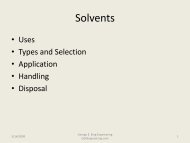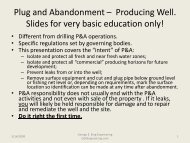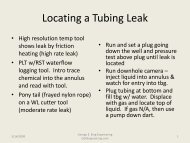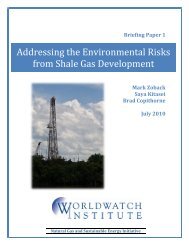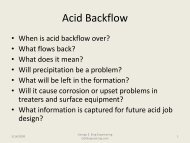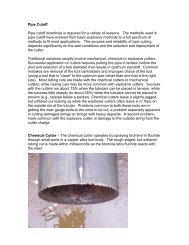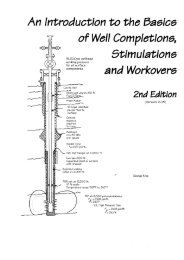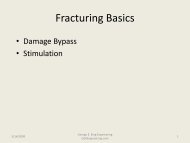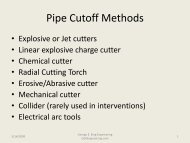Scales - George E King Petroleum Engineering Oil and Gas ...
Scales - George E King Petroleum Engineering Oil and Gas ...
Scales - George E King Petroleum Engineering Oil and Gas ...
Create successful ePaper yourself
Turn your PDF publications into a flip-book with our unique Google optimized e-Paper software.
<strong>Scales</strong><br />
• Usually a precipitate from a brine that<br />
becomes saturated with a material due to a<br />
change in the flowing fluid conditions within a<br />
well.<br />
• Scale precipitation may be driven by mixing<br />
incompatible waters, but can also be caused<br />
by out-gassing, shear, turbulence, <strong>and</strong><br />
temperature <strong>and</strong> pressure loss – upsets in the<br />
flowing equilibrium.<br />
3/14/2009 1<br />
<strong>George</strong> E. <strong>King</strong> <strong>Engineering</strong><br />
GEK<strong>Engineering</strong>.com
<strong>Scales</strong><br />
• calcium carbonate - upset<br />
driven<br />
• calcium sulfate - mixing<br />
waters, upset, CO 2<br />
• barium sulfate - mixing<br />
waters, upset<br />
• iron scales - corrosion,<br />
H 2 S, low pH, O 2<br />
• rarer scales - heavy brines<br />
Saturation Index<br />
1.5<br />
1<br />
0.5<br />
0<br />
-0.5<br />
Saturation Indices for Scale Formation Potential for an<br />
Example Formation Water<br />
Calcite (CaCO3)<br />
Gypsum (CaSO4)<br />
90 140 190 240<br />
-1<br />
-1.5<br />
Temperature, F<br />
3/14/2009 2<br />
<strong>George</strong> E. <strong>King</strong> <strong>Engineering</strong><br />
GEK<strong>Engineering</strong>.com
Some scales form in layers, often driven by an “upset” in the flow dynamics of the system.<br />
These deposits can form almost anywhere, on any surface, but the deposits are usually just<br />
downstream of the location of an upset in the flow system. The location of the scale is often an<br />
indicator of what is causing the precipitation.<br />
3/14/2009 3<br />
<strong>George</strong> E. <strong>King</strong> <strong>Engineering</strong><br />
GEK<strong>Engineering</strong>.com
Calcium sulfate scale from slow growth in a high water cut reservoir.<br />
3/14/2009 4<br />
<strong>George</strong> E. <strong>King</strong> <strong>Engineering</strong><br />
GEK<strong>Engineering</strong>.com
A rapidly formed deposit of calcium sulfate formed after an acid was mixed with a scale<br />
dissolver chemical that had removed a deposit of calcium sulfate scale at the perforations.<br />
3/14/2009 5<br />
<strong>George</strong> E. <strong>King</strong> <strong>Engineering</strong><br />
GEK<strong>Engineering</strong>.com
Calcium Sulfate scale that completely blocked a section of<br />
downhole tubing – this piece was from a connection.<br />
3/14/2009 6<br />
<strong>George</strong> E. <strong>King</strong> <strong>Engineering</strong><br />
GEK<strong>Engineering</strong>.com
A very unusual form of calcium carbonate scale – small pellets – 1/8” or 3 mm of carbonate<br />
scale formed around a grain of s<strong>and</strong>. Bailed from an East Texas well with natural flow (strong<br />
water drive) <strong>and</strong> significant rolling water in the bottom. When the pellets got so heavy they<br />
could not be supported, they sank. <strong>Oil</strong> Well Pearls?<br />
3/14/2009 7<br />
<strong>George</strong> E. <strong>King</strong> <strong>Engineering</strong><br />
GEK<strong>Engineering</strong>.com
Calcium sulfate crystals removed from a flow line in West Texas.<br />
3/14/2009 8<br />
<strong>George</strong> E. <strong>King</strong> <strong>Engineering</strong><br />
GEK<strong>Engineering</strong>.com
Barium Sulfate deposition from topsides piping on a North Sea platform in the early 1990’s. The<br />
scale was not radioactive, but was nearly pure BaSO4. There was almost no reaction in several<br />
days in a test with the best EDTA <strong>and</strong> DPTA Barium dissolvers.<br />
3/14/2009 9<br />
<strong>George</strong> E. <strong>King</strong> <strong>Engineering</strong><br />
GEK<strong>Engineering</strong>.com
NORM <strong>Scales</strong><br />
• NORM is Naturally Occurring Radioactive<br />
Material<br />
• <strong>Scales</strong> which form concentrates of various<br />
naturally occurring radionuclides (NOR’s),<br />
present in almost all of the earth’s crust.<br />
• NOR’s present in water, gas, sludge <strong>and</strong> scale.<br />
3/14/2009 10<br />
<strong>George</strong> E. <strong>King</strong> <strong>Engineering</strong><br />
GEK<strong>Engineering</strong>.com
What’s Radioactive?<br />
• Uranium series 238 U <strong>and</strong> 226 Ra<br />
• Thorium series, 232 Th<br />
• Potassium 40 K<br />
• And their gamma-ray emitting products.<br />
3/14/2009 11<br />
<strong>George</strong> E. <strong>King</strong> <strong>Engineering</strong><br />
GEK<strong>Engineering</strong>.com
Scale Location<br />
• at pressure drops - perfs, profiles<br />
• water mixing points - leaks, flood breakthru<br />
• outgassing points - hydrostatic sensitive<br />
• shear points - pumps, perfs, chokes,<br />
• gravel pack - formation interface<br />
3/14/2009 12<br />
<strong>George</strong> E. <strong>King</strong> <strong>Engineering</strong><br />
GEK<strong>Engineering</strong>.com
Why Does Scale Form?<br />
• Sulphates:<br />
Ba 2+ + SO<br />
2-<br />
4 BaSO 4<br />
FW SW<br />
–Mixing of Incompatible waters (e.g. Formation <strong>and</strong> Sea<br />
water)<br />
–e.g. when Sea water breaks through in a production well<br />
already containing Formation water<br />
–e.g. When injecting Sea water into a Reservoir water Leg,<br />
or in the presence of Connate or Formation water<br />
3/14/2009 13<br />
<strong>George</strong> E. <strong>King</strong> <strong>Engineering</strong><br />
GEK<strong>Engineering</strong>.com
Temperature <strong>and</strong> Pressure<br />
• Carbonate is Less Soluble with increasing temperature<br />
<strong>and</strong> Reducing Pressure<br />
• Sulphates tend to be more soluble with increasing<br />
temperature <strong>and</strong> pressure (less of an effect)<br />
• These are general rules, but there are exceptions...each<br />
scale needs to be evaluated under prevailing conditions<br />
• Increasing salinity tends to increase solubility of both<br />
3/14/2009 14<br />
<strong>George</strong> E. <strong>King</strong> <strong>Engineering</strong><br />
GEK<strong>Engineering</strong>.com
Scale Prediction<br />
• Chemical models - require water analysis <strong>and</strong><br />
well conditions<br />
• Predictions are usually a “worst case” - this is<br />
where the “upset” factor comes in.<br />
– added shear - increased drawdown, choke<br />
changes, etc.<br />
– acidizing<br />
– venting pressure<br />
3/14/2009 15<br />
<strong>George</strong> E. <strong>King</strong> <strong>Engineering</strong><br />
GEK<strong>Engineering</strong>.com
Water Composition<br />
Concentration (ppm)<br />
Ion<br />
Sea Water<br />
Forties<br />
Miller<br />
Gyda<br />
Prudhoe Bay<br />
Na<br />
K<br />
Mg<br />
Ca<br />
Sr<br />
Ba<br />
CI<br />
SO 4<br />
HCO 3<br />
10890<br />
460<br />
1368<br />
428<br />
8<br />
0<br />
19700<br />
2960<br />
124<br />
29370<br />
372<br />
504<br />
2808<br />
574<br />
252<br />
52360<br />
0<br />
496<br />
28780<br />
1830<br />
115<br />
1060<br />
110<br />
1050<br />
47680<br />
0<br />
2090<br />
65340<br />
5640<br />
2325<br />
30185<br />
1085<br />
485<br />
167400<br />
0<br />
76<br />
8000<br />
83<br />
84<br />
180<br />
24<br />
4<br />
11500<br />
10<br />
2222<br />
3/14/2009 16<br />
<strong>George</strong> E. <strong>King</strong> <strong>Engineering</strong><br />
GEK<strong>Engineering</strong>.com
Example of North Sea Scaling Indices<br />
for Formation / Sea Water Mixture<br />
450<br />
400<br />
350<br />
Calcite<br />
Anhydrite<br />
Barite<br />
Celestite<br />
300<br />
250<br />
200<br />
150<br />
100<br />
• SI = 1 equilibrium<br />
• SI > 1 over saturated, pptn predicted<br />
50<br />
0<br />
0 10 20 30 40 50 60 70 80 90 100<br />
% Seawater<br />
3/14/2009 17<br />
<strong>George</strong> E. <strong>King</strong> <strong>Engineering</strong><br />
GEK<strong>Engineering</strong>.com
Calcium sulfate growth rates for various stimulation methods (upsets).<br />
<strong>George</strong> E. <strong>King</strong> <strong>Engineering</strong><br />
3/14/2009 18<br />
GEK<strong>Engineering</strong>.com
How do we Control Scale?<br />
• Inhibition<br />
– Downhole<br />
– Subsea<br />
– Topsides<br />
• Stop mixing of incompatible waters<br />
– PWRI Vs SWI (Harding)<br />
– Use De-Sulphated sea water (Marathon)<br />
– Train segregation (Bruce, ETAP)<br />
• Remedial Action<br />
– Chemical Dissolution<br />
– Mechanical Removal<br />
3/14/2009 19<br />
<strong>George</strong> E. <strong>King</strong> <strong>Engineering</strong><br />
GEK<strong>Engineering</strong>.com
How Do They Work?<br />
• Crystal Modifiers<br />
– These chemicals are believed to work predominantly by<br />
retarding crystal growth.<br />
– Promote the formation of small crystals, which act as<br />
nucleation sites, yet prevent them from becoming large<br />
enough to precipitate from solution<br />
– The initial nucleation reduces the supersaturation of the<br />
solution quickly<br />
– The large molecules attach to active crystal growth planes<br />
<strong>and</strong> block growth in one particular direction<br />
3/14/2009 20<br />
<strong>George</strong> E. <strong>King</strong> <strong>Engineering</strong><br />
GEK<strong>Engineering</strong>.com
How Do They Work<br />
• Threshold Inhibitors<br />
– These chemicals inhibit predominantly by preventing<br />
crystal nucleation<br />
– They stop the ions from aggregating together <strong>and</strong> in effect<br />
delay scale formation<br />
3/14/2009 21<br />
<strong>George</strong> E. <strong>King</strong> <strong>Engineering</strong><br />
GEK<strong>Engineering</strong>.com
Inhibitor Deployment<br />
Above the Packer<br />
• Continuous Injection via Chemical Injection<br />
Control Line (Macaroni string)<br />
– Well integrity (leak path)<br />
– Increases well completion running times (rig<br />
costs?)<br />
– Blockage issue<br />
• Continuous Injection via <strong>Gas</strong> Lift<br />
– Atomisation <strong>and</strong> Gunking issue<br />
– Orifice to Packer Volume<br />
3/14/2009 22<br />
<strong>George</strong> E. <strong>King</strong> <strong>Engineering</strong><br />
GEK<strong>Engineering</strong>.com
Inhibitor Deployment<br />
Below the Packer<br />
• Matrix squeezes with scale inhibitor<br />
– Adsorption <strong>and</strong> Absorption<br />
– Precipitation squeezes<br />
• Impregnated proppant (short lived)<br />
• Continuous Inhibition from capillary<br />
• Inhibitor placement in the rat hole<br />
3/14/2009 23<br />
<strong>George</strong> E. <strong>King</strong> <strong>Engineering</strong><br />
GEK<strong>Engineering</strong>.com
Scale Inhibitor Squeeze Treatments<br />
• Bull heading<br />
– Chemicals pumped directly down<br />
well (rate 3-30 bpm)<br />
• Pre-flush flush<br />
– typical vol. 50bbls<br />
– maximize contact with rock <strong>and</strong><br />
minimizes near well bore damage<br />
• Main treatment<br />
– typical vol. 50 – 500 bbls of actual<br />
chemical required for inhibition,<br />
mixed in compatible fluid.<br />
• Overflush<br />
– typical vol. 50 to over 1000bbls<br />
– ensures deeper placement of<br />
chemicals<br />
S tag e 1: Preflush<br />
Stage 2: Pump Scale Inhibitor<br />
Stage 3: Pump Overflush<br />
Stage 4: Shut in<br />
Stage 5: Return the well to production - inhibitor is slowly<br />
<strong>George</strong> E. <strong>King</strong> <strong>Engineering</strong><br />
3/14/2009 24<br />
GEK<strong>Engineering</strong>.com<br />
released into the well.
Inhibitors can be squeezed into the formation, returning slowly. There is a “threshold” level of<br />
inhibitor needed to prevent scale in a specific well system. When the inhibitor level falls below<br />
the threshold, scale can form.<br />
Optimizing inhibitor squeeze design can change the useful inhibitor life from a few weeks to 12<br />
to 18 months.<br />
60.<br />
Milne Point L-40 well. Inhibitor return data<br />
Active Inhibitor Content / ppm<br />
50.<br />
40.<br />
30.<br />
20.<br />
10.<br />
0.<br />
0 50 100 150 200<br />
Elapsed Time / days<br />
<strong>George</strong> E. <strong>King</strong> <strong>Engineering</strong><br />
3/14/2009 25<br />
GEK<strong>Engineering</strong>.com<br />
AEA
Scale Removal<br />
• Calcium Carbonate - HCl, EDTA<br />
• Calcium Sulfate - EDTA <strong>and</strong> converters<br />
• Barium Sulfate mixtures - PDTA <strong>and</strong> EDTA<br />
• Pure Barium Sulfate - mechanical<br />
• Thick deposits of any sulfate scale -<br />
mechanical removal<br />
3/14/2009 26<br />
<strong>George</strong> E. <strong>King</strong> <strong>Engineering</strong><br />
GEK<strong>Engineering</strong>.com
Scale Removal<br />
• Chemical Dissolution – Scale Dissolvers<br />
• Carbonates<br />
– Mineral Acids (e.g. HCl, Acetic Acid) <strong>and</strong> EDTA <strong>and</strong> DPTA<br />
• Calcium Sulfate<br />
– Chelants (e.g. EDTA <strong>and</strong> DPTA based) <strong>and</strong> Converters (strong bases)<br />
• Barium Sulfate – treat only scale mixtures, too slow on pure BaSO4 under pressure.<br />
• Mechanical Removal<br />
– Milling with carefully selected mills – also watch the hydraulics.<br />
– Under-reaming under restrictions (under-reamers are slower than mills).<br />
• Multiple trips in tapered diameter completion string<br />
• Problems with nipple profiles<br />
– Jetting with Solid Beads (e.g. abrasives) – tubing damage potential is moderate to high.<br />
– Shock (e.g. String Shot) – 1 to a maximum of 4 str<strong>and</strong>s of 90 grain RDX.<br />
3/14/2009 27<br />
<strong>George</strong> E. <strong>King</strong> <strong>Engineering</strong><br />
GEK<strong>Engineering</strong>.com
<strong>Scales</strong><br />
• calcium carbonate - upset driven<br />
• calcium sulfate - mixing waters, upset, CO 2<br />
• barium sulfate - mixing waters, upset<br />
• iron scales - corrosion, H 2 S, low pH, O 2<br />
• rarer scales - heavy brines create zinc <strong>and</strong><br />
other metal sulfides.<br />
3/14/2009 28<br />
<strong>George</strong> E. <strong>King</strong> <strong>Engineering</strong><br />
GEK<strong>Engineering</strong>.com
Problems with over-running the dissolver or<br />
converter with acid – the resulting reaction<br />
can re-precipitate everything!<br />
Calcium sulfate scale precipitated from a<br />
scale dissolver solution of EDTA when<br />
treated with 15% HCl..<br />
Most dissolvers <strong>and</strong> converters cannot hold<br />
the by-products in solution as pH drops.<br />
3/14/2009 29<br />
<strong>George</strong> E. <strong>King</strong> <strong>Engineering</strong><br />
GEK<strong>Engineering</strong>.com
Sale – Know Why.<br />
• <strong>Scales</strong> precipitate due to fluid mixing, upsets<br />
in flowing conditions, cooling, heating,<br />
corrosion, acidizing <strong>and</strong> other factors.<br />
Underst<strong>and</strong> why.<br />
• Is it easier to prevent the scale or remove it<br />
once it has formed? It depends on the<br />
individual well conditions, e.g., access, cost,<br />
impact, etc.<br />
3/14/2009 30<br />
<strong>George</strong> E. <strong>King</strong> <strong>Engineering</strong><br />
GEK<strong>Engineering</strong>.com



